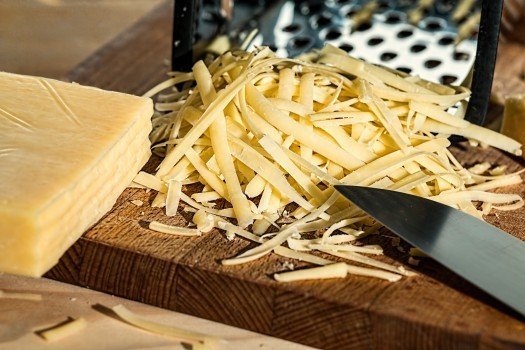The charm of cheese
Cheese is a dairy product derived from milk that is produced in a wide range of flavors, textures, and forms by coagulation of the milk protein casein. It comprises proteins and fat from milk, usually the milk of cows, buffalo, goats, or sheep. During production, the milk is usually acidified, and adding the enzyme rennet causes coagulation. The solids are separated and pressed into final form.
Origins
Cheese is an ancient food whose origins predate recorded history. There is no conclusive evidence indicating where cheesemaking originated, whether in Europe, Central Asia or the Middle East, but the practice had spread within Europe prior to Roman times and, according to Pliny the Elder, had become a sophisticated enterprise by the time the Roman Empire came into being.
Earliest proposed dates for the origin of cheesemaking range from around 8000 BCE when sheep were first domesticated. Since animal skins and inflated internal organs have, since ancient times, provided storage vessels for a range of foodstuffs, it is probable that the process of cheese making was discovered accidentally by storing milk in a container made from the stomach of an animal, resulting in the milk being turned to curd and whey by the rennet from the stomach.
The earliest evidence of cheesemaking in the archaeological record dates back to 5500 BCE and is found in what is now Kujawy, Poland, where strainers coated with milk-fat molecules have been found.
Cheesemaking may have begun independently of this by the pressing and salting of curdled milk to preserve it. The observation that the effect of making cheese in an animal stomach gave more solid and better-textured curds may have led to the deliberate addition of rennet. Early archeological evidence of Egyptian cheese has been found in Egyptian tomb murals, dating to about 2000 BCE.
The earliest cheeses were likely quite sour and salty, similar in texture to rustic cottage cheese or feta, a crumbly, flavorful Greek cheese. Cheese produced in Europe, where climates are cooler than the Middle East, required less salt for preservation. With less salt and acidity, the cheese became a suitable environment for useful microbes and molds, giving aged cheeses their respective flavors. The earliest ever discovered preserved cheese was found in the Taklamakan Desert in Xinjiang, China, and it dates back as early as 1615 BCE.
There is a legend – with variations – about the discovery of cheese by an Arab trader who used this method of storing milk.
A 2018 paper published in Analytical Chemistry stated that the world's oldest cheese, dating to approximately 3200 years before present, was found in ancient Egyptian tombs.
Types
Fresh Cheese
Without mature processing, the milk is solidified directly to remove some moisture. The texture is soft and moist, giving off fresh milk and lightly sour taste. It is refreshing. But the storage period is very short.
White mold cheese
The epidermis is covered with white fungal villi, which can keep the fungi and molds on the epidermis when eating and can also be removed according to the taste. The texture is very soft and rich in milk flavor. Generally, this cheese is not used for cooking.
Blue cheese
Under the action of penicillin, a marble-like blue-green pattern is formed, which is more spicy and stimulating than white mold cheese.
Soft cheese with the washed rind
Ripening requires frequent scrubbing with saline water or local specialty liquor, with orange-red skin, soft interior, mellow taste, and rich aroma.
Semi-hard cheese
In the manufacturing process, the pressure is strong and moisture is removed. The taste is mild and smooth and easy to be accepted by the general public. Because its texture is easy to dissolve, it is often used in cooking dishes.
Hard cheese
It needs extrusion and boiling when it is made. Its texture is hard and its fragrance is sweet and thought-provoking. It can be transported and stored for a long time.
Goat cheese
The most classic goat cheese is made in the same way as fresh cheese. It can be eaten fresh or after dehydration. Small size, diverse shapes, and slightly sour taste.
Processed cheese
More than one extruded cheese group is made after melting, adding milk, butter or butter. Different products can add different ingredients, such as vanilla, nuts and so on. The taste is not strong, it can be preserved for a long time.
Cream cheese
A kind of immature full-fat cheese, after processing, its fat content can exceed 50%, delicate texture, and soft taste.
Child cheese
A kind of cheese for children, more emphasis on taste nutrition, Badgeford stick cheese, and growing cheese are rich in protein, calcium content than ordinary milk and high calcium milk can provide adequate nutrition.
Some Cheese Recipes
1. Oreo Cookie Cheesecake
Cheese used: Cream cheese
A much-loved dessert made with crunchy oreo cookies, luscious cream cheese, and melted chocolate. This cake is a sweet sweet blessing!
2. Margherita Pizza
Cheese used: Mozzarella cheese
When you think of cheese, does an image of a piping hot pizza flash across your eyes? Well then, here's the recipe of the classic Margherita pizza with mozzarella cheese (famously known as the pizza cheese!) and basil leaves.
3. Watermelon, Olive and Feta Salad
Cheese used: Feta cheese
The perfect summer salad of melon, olives and feta cheese with toasted pumpkin seeds. The sweetness of watermelon is balanced well with chaat masala, lemon and soy sauce. A melange of flavors!
4. Savory Corn Tarts
Cheese used: Cheddar cheese; Ricotta cheese
Party snacks get a healthy makeover! Go gluten-free with these savory tarts made with maize flour and filled with a cheesy vegetable mix.
5. Gratin of Potatoes with Garlic Cream
Cheese used: Gruyere cheese; Cheddar cheese; Parmesan cheese
Dig deep into layers of sliced, seasoned potatoes and three types of cheese, baked golden brown with garlic-y undertones.
6. Cheese and Pesto Eggplant
Cheese used: Parmesan or Cheddar
Eggplant laced with Parmesan cheese and baked in freshly made pesto sauce.
7. Four Cheese Pasta
Cheese used: Swiss Emmental cheese; Cheddar cheese; Parmesan cheese; Brie cheese
Cheese lovers, rejoice! Gourmet macaroni cheese with parmesan, cheddar, brie, and emmental. This recipe is as cheesy as it can get.
8. Cheese Fondue
Cheese used: Swiss Emmental cheese; Gruyere cheese
Fondue is a Swiss dish made with melted cheese. Emmenthaler and Gruyere cheese melted and drizzled with some white wine. Dip blanched vegetables like broccoli and baby corn in this hot mixture and enjoy the cheesiness in every bite.
9. French Onion Soup with Cheese Souffle
Cheese used: Any or mozzarella cheese
An old world classic - a broth of sweet caramelized onions topped with a cheesy souffle as light as a feather. Baked till the cheese melts and served immediately, this one's a slurp that warms your soul!
Related Articles
Search
Categories
Popular Posts





















Comments: 0
No comments